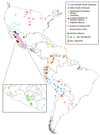A single domestication for maize shown by multilocus microsatellite genotyping
- PMID: 11983901
- PMCID: PMC122905
- DOI: 10.1073/pnas.052125199
A single domestication for maize shown by multilocus microsatellite genotyping
Abstract
There exists extraordinary morphological and genetic diversity among the maize landraces that have been developed by pre-Columbian cultivators. To explain this high level of diversity in maize, several authors have proposed that maize landraces were the products of multiple independent domestications from their wild relative (teosinte). We present phylogenetic analyses based on 264 individual plants, each genotyped at 99 microsatellites, that challenge the multiple-origins hypothesis. Instead, our results indicate that all maize arose from a single domestication in southern Mexico about 9,000 years ago. Our analyses also indicate that the oldest surviving maize types are those of the Mexican highlands with maize spreading from this region over the Americas along two major paths. Our phylogenetic work is consistent with a model based on the archaeological record suggesting that maize diversified in the highlands of Mexico before spreading to the lowlands. We also found only modest evidence for postdomestication gene flow from teosinte into maize.
Figures



Similar articles
-
Domestication and lowland adaptation of coastal preceramic maize from Paredones, Peru.Elife. 2023 Apr 18;12:e83149. doi: 10.7554/eLife.83149. Elife. 2023. PMID: 37070964 Free PMC article.
-
Genetic diversity and population structure of teosinte.Genetics. 2005 Apr;169(4):2241-54. doi: 10.1534/genetics.104.031393. Epub 2005 Jan 31. Genetics. 2005. PMID: 15687282 Free PMC article.
-
Evidence of selection at the ramosa1 locus during maize domestication.Mol Ecol. 2010 Apr;19(7):1296-311. doi: 10.1111/j.1365-294X.2010.04562.x. Epub 2010 Feb 24. Mol Ecol. 2010. PMID: 20196812
-
Genomic screening for artificial selection during domestication and improvement in maize.Ann Bot. 2007 Nov;100(5):967-73. doi: 10.1093/aob/mcm173. Epub 2007 Aug 18. Ann Bot. 2007. PMID: 17704539 Free PMC article. Review.
-
The genetics of maize evolution.Annu Rev Genet. 2004;38:37-59. doi: 10.1146/annurev.genet.38.072902.092425. Annu Rev Genet. 2004. PMID: 15568971 Review.
Cited by
-
Identification and segregation of two closely linked major QTLs for kernel row number in advanced maize-teosinte populations.Theor Appl Genet. 2024 Nov 18;137(12):271. doi: 10.1007/s00122-024-04780-0. Theor Appl Genet. 2024. PMID: 39557680
-
Genome-Wide Identification of COMT Gene Family in Maize and its Function in Response to Light.Biochem Genet. 2024 Oct 23. doi: 10.1007/s10528-024-10942-y. Online ahead of print. Biochem Genet. 2024. PMID: 39443412
-
Current Insights into Weak Seed Dormancy and Pre-Harvest Sprouting in Crop Species.Plants (Basel). 2024 Sep 12;13(18):2559. doi: 10.3390/plants13182559. Plants (Basel). 2024. PMID: 39339534 Free PMC article. Review.
-
Archaeological findings show the extent of primitive characteristics of maize in South America.Sci Adv. 2024 Sep 6;10(36):eadn1466. doi: 10.1126/sciadv.adn1466. Epub 2024 Sep 4. Sci Adv. 2024. PMID: 39231236 Free PMC article.
-
Phylogenomics analysis of Scutellaria (Lamiaceae) of the world.BMC Biol. 2024 Sep 2;22(1):185. doi: 10.1186/s12915-024-01982-2. BMC Biol. 2024. PMID: 39218872 Free PMC article.
References
-
- Second G. Jpn J Genet. 1982;57:25–57.
-
- Sonnante G, Stockton T, Nodari R O, Becerra Velásquez V L, Gepts P. Theor Appl Genet. 1994;89:629–635. - PubMed
-
- Yabuno T. Cytologia. 1962;27:296–305.
-
- Wendel J F. In: Evolution of Crop Plants. Smartt J, Simmonds N W, editors. Essex, U.K.: Longman; 1995. pp. 358–366.
-
- Decker D S. Econ Bot. 1988;42:4–15.
Publication types
MeSH terms
LinkOut - more resources
Full Text Sources
Other Literature Sources


